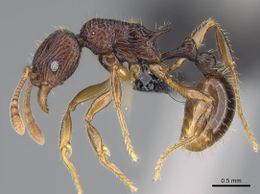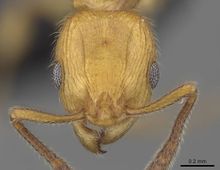Key to Vitsika workers
This worker key is based on: Bolton, B. & Fisher, B.L. 2014. The Madagascan endemic myrmicine ants related to Eutetramorium (Hymenoptera: Formicidae): taxonomy of the genera Eutetramorium Emery, Malagidris nom. n., Myrmisaraka gen. n., Royidris gen. n., and Vitsika gen. n. Zootaxa 3791:1–99. doi:10.11646/zootaxa.3791.1.1
You may also be interested in
Note. This key excludes ergatoid gynes and alate-ergatoid intermediates (i.e. any worker-like individual which possesses a hypertrophied mesonotum, or has 1–3 ocelli, or has both these features present, is omitted).
1
- Full adult colour red-brown, dark brown, or almost black; decidedly not yellow . . . . . 2
- Full adult colour yellow to light brownish yellow . . . . . 6
2
return to couplet #1
- With petiole node in posterior view the dorsal margin markedly concave across part or most of the width . . . . . Vitsika incisura
- With petiole node in posterior view the dorsal margin convex, varying from shallowly convex to almost conical . . . . . 3
3
return to couplet #2
- In profile the postpetiole almost paniform, long and low, the node distinctly longer than the postpetiole is high, and with a long, shallowly convex dorsal outline . . . . . Vitsika labes
- In profile the postpetiole distinctly nodiform, the node at least as high as the postpetiole is long, usually higher, and the node with a strongly convex dorsal outline . . . . . 4
4
return to couplet #3
- In posterior view the dorsum of the petiole node is very narrowly rounded, rising medially to a point that is blunt to acute. Petiole node in posterior view tall and slender, higher than wide, its height (from midpoint of the dorsal margin of the foramen to the apex) 1.10–1.23 × its maximum width . . . . . Vitsika manifesta
- In posterior view the dorsum of the petiole node is broadly and shallowly convex to almost flat medially. Petiole node in posterior view low and broad, wider than high, its height (from midpoint of the dorsal margin of the foramen to the apex) 0.78–0.92 × its maximum width . . . . . 5
5
return to couplet #4
- Smaller species, HL 0.78–0.84, HW 0.62–0.73, SL 0.54–0.63, WL 1.00–1.08. Metafemur shorter, MfL 0.68–0.78 (MfL/HW 1.06–1.09). Antennal scape brown, about the same shade as the head capsule or fractionally lighter. Full adult colour of head and mesosoma blackish brown to black. Mesopleuron with 7–8 relatively crowded longitudinal costulae, the spaces between them with weak punctulate ground-sculpture . . . . . Vitsika miranda
- Larger species, HL 0.91–0.92, HW 0.75–0.78, SL 0.68–0.69, WL 1.20–1.22. Metafemur longer, MfL 0.86–0.88 (MfL/HW 1.11–1.16). Antennal scape yellow, conspicuously lighter in shade than the head capsule. Full adult colour of head and mesosoma brown. Mesopleuron with 5–6 relatively widely spaced longitudinal costulae, the spaces between them almost entirely smooth . . . . . Vitsika obscura
6
return to couplet #1
- Dorsum of postpetiole entirely covered with dense, conspicuous reticulate-punctate ground sculpture, and also with some weak rugulae. Propodeal spines short and their apices close together in relation to postpetiole width: in dorsal view maximum width of postpetiole 1.95–2.25 × the length of a propodeal spine; maximum width of postpetiole 1.25–1.50 × the distance between the apices of the propodeal spines. In addition, postpetiole in dorsal view 1.35–1.45 × broader than long . . . . . Vitsika crebra
- Dorsum of postpetiole usually smooth, but sometimes with weak or partial punctulation, or with a few laterodorsal costulae. Propodeal spines always longer and their apices closer together in relation to postpetiole width: in dorsal view maximum width of postpetiole 0.90–1.60 × the length of a propodeal spine; maximum width of postpetiole 0.82–1.22 × the distance between the apices of the propodeal spines. In addition, postpetiole in dorsal view 1.00–1.38 × broader than long . . . . . 7
7
return to couplet #6
- Antennal scape relatively shorter, SI 73–76. Propodeal spines relatively shorter, maximum dorsal width of postpetiole 1.25–1.60 × the length of a spine (only rarely < 1.30). Metafemur always slightly shorter than head width (MfL/HW 0.85–0.92). Petiole node in profile low, thick from front to back, and with an oblique to broadly rounded dorsal surface . . . . . Vitsika breviscapa
- Antennal scape relatively longer, SI 80–91. Propodeal spines relatively longer, maximum dorsal width of postpetiole 0.90–1.36 × the length of a spine (only extremely rarely > 1.25). Metafemur about the same length as, or slightly longer than, head width (MfL/HW 0.98–1.13). Petiole node in profile high, narrow from front to back, and usually narrowly rounded to bluntly cuneate dorsally . . . . . 8
8
return to couplet #7
- In profile the postpetiole almost paniform, long and low, the node distinctly longer than the postpetiole is high, and with a shallowly convex dorsal outline . . . . . Vitsika venustas
- In profile the postpetiole distinctly nodiform, the node at least as high as the postpetiole is long, usually higher, and the node with a strongly convex dorsal outline . . . . . 9
9
return to couplet #8
- With petiole in profile the dorsal surface of the peduncle runs into the anterior face of the node through a very obtuse angle, so that the anterior face of the node slopes upwards and posteriorly at only a shallow angle relative to the dorsum of the peduncle . . . . . Vitsika acclivitas
- With petiole in profile the dorsal surface of the peduncle runs into the anterior face of the node through slightly more than a right-angle, so that the anterior face of the node slopes upwards and posteriorly at a steep angle relative to the dorsum of the peduncle . . . . . 10
10
return to couplet #9
- Average size of worker larger, HW 0.60–0.71, SL 0.54–0.62, MfL 0.66–0.80. Petiole node smooth, without costulae or rugulae on the anterior, lateral or posterior surfaces. Postpetiole in dorsal view smooth, without punctulate sculpture and without longitudinal costulae laterodorsally . . . . . Vitsika astuta
- Average size of worker smaller, HW 0.48–0.62, SL 0.38–0.52, MfL 0.48–0.66. If HW 0.60–0.62 and SL 0.50–0.52, then petiole in profile with fine costulae or rugulae that ascend the anterior surface, traverse the upper portion of the lateral surface, and usually overlap onto the posterior surface. Postpetiole in dorsal view with weak but obvious punctulate sculpture, at least on the posterior half, and laterodorsally with longitudinal costulae present . . . . . 11
11
return to couplet #10
- With mesosoma in profile the dorsal outline of the propodeum rises to a marked peak or angle posterior to the site of the metanotal groove, then descends abruptly and steeply to the dorsal base of the propodeal spine. Petiole node entirely unsculptured . . . . . Vitsika disjuncta
- With mesosoma in profile the dorsal outline of the propodeum is usually evenly, shallowly curved from the site of the metanotal groove to the dorsal base of the propodeal spine. If a weak angular prominence is present in the outline of the propodeal dorsum, then the petiole node has sculpture on some or all of its surfaces . . . . . 12
12
return to couplet #11
- Eye smaller, with 5–6 longitudinal rows of ommatidia, and with 6–7 ommatidia in the longest row. Smaller species, WL 0.62–0.74, MfL 0.45–0.52, HW 0.46–0.52, SL 0.38–0.45. Postpetiole in dorsal view 1.20–1.38 × broader than long. Propodeal spines usually (but not always) strikingly downcurved along their length . . . . . Vitsika tenuis
- Eye larger, with 7–8 longitudinal rows of ommatidia, and with 9–10 ommatidia in the longest row. Larger species, WL 0.84–0.96, MfL 0.54–0.66, HW 0.53–0.60, SL 0.46–0.52. Postpetiole in dorsal view 1.08–1.20 × broader than long. Propodeal spines never strikingly downcurved along their length . . . . . 13
13
return to couplet #12
- With petiole node in profile its sculpture conspicuous, with distinct costulae or rugulae that ascend the anterolateral surface, traverse the upper side of the node, and usually overlap onto the posterior surface. Dorsum of postpetiole mostly to entirely weakly punctulate, and also with laterodorsal longitudinal costulae present . . . . . Vitsika procera
- With petiole node in profile its sculpture weak to vestigial, at most with very feeble, slender costulae that ascend the anterolateral surface, and with traces of punctulate sculpture laterally; posterior surface of node smooth. Dorsum of postpetiole mostly to entirely unsculptured, at most with some weak punctulation posteriorly, and laterodorsal longitudinal costulae or weak punctulation may be present . . . . . Vitsika suspicax



























